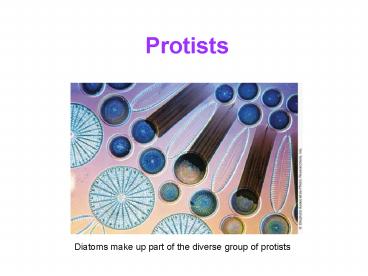Protists - PowerPoint PPT Presentation
1 / 22
Title:
Protists
Description:
Amoeba, Paramecium. Plant Like Protists - Autotrophic. MAKE their own food. Ex. Euglena ... Paramecium. Figure 28.14c Ciliates: Paramecium. Conjugation in Ciliates ... – PowerPoint PPT presentation
Number of Views:329
Avg rating:3.0/5.0
Title: Protists
1
Protists
Diatoms make up part of the diverse group of
protists
2
What is a Protist?
- Classified in Kingdom Protista
- Protista means very first
- Loosely related group of micro orgs.
- Believed to evolved 1.5 million years ago due to
symbiotic relationshipsee next slide - --Unicellular, Colonial, or Multicellular
- --NOT a plant, animal or fungi
- are the simplest Eukaryotes
- Have a nucleus and membrane-bound organelles
3
Endosymbiosis Evolution from Bacteria
Proposed by Lynn Marguilis endosymbiosis/Gaia
Theory Proof separate DNA and extra membranes
around mitochondra and Chloroplasts
4
Classification of Protists
- Problem to classify because of diversity
- Basically, protist classification is based on
mode of nutrition - Animal Like Protists - Heterotrophic
- Must EAT their food
- Move around like animals
- Ex. Amoeba, Paramecium
- Plant Like Protists - Autotrophic
- MAKE their own food
- Ex. Euglena
- 3. Fungal Like Protists Decomposers/Parasites
- ABSORB their food externally
- Ex. Slime molds
5
Animal-Like Protists
- Once called Protozoans First Animals
- Make up 70 Percent of all Human Parasites
- 4 Types of Animal-Like Protists
- Based on how they move
- 1. Zooflagellates use flagella to move
- 2. Sarcodines move by extension in cytoplasm
- Called pseudopodia (false feet)
- 3. Ciliates use cilia to move
- 4. Sporozoans do not move at all
6
Sarcodine AnatomyEx Ameoba
7
Ciliates
- Use cilia to move and obtain food
- Very organized anatomy
- 2 nuclei macronuclei and micronuclei
- Oral Groove mouth-like structure
- Gullet stomach like structure
- Anal pore waste release
- Contractile vacuole store, pump water
- Pellicle rigid protein cover, anchors flagella,
cilia - Trichocysts projections that protect the cell
- Ex Paramecium
8
Cilliate AnatomyParamecium
9
Figure 28.14c Ciliates Paramecium
10
Conjugation in Ciliates
- Typically use Asexual Binary Fission
- If stressed can use Conjugation
- Sexual recombination of genes
- NOT Reproduction (No NEW individuals)
- Actually produces clones!!! Why?
- Meiosis of one micro nucleus in each org
- Two orgs swap new micronuclei
- Macro nuclei dissolve and micro becomes
macronuclei - New Macronucleus is part self and part other org
in both
11
Plant Like Protists
- Main Characteristic Chlorophyll
- Green Pigment- traps light, carries out
photosynthesis - Evolved from symbiosis of photosynthetic bacteria
and larger, heterotrophic bacteria - Commonly called Algae
- Can contain cell wall like plants
12
Euglena Anatomy
13
DiatomsPhylum Bacillariophyta
- Some of the most abundant orgs on earth
- Produce Silicon in outer cell wall glass like
- Patterns and rigid structures
- In death, cell walls produce Diatomaceous Earth
- Abrasive compound used in toothpaste and
filtration systems
14
Some Plant-like protists have adverse effects
- Algal Blooms High levels of nutrients/wastes in
water - Cause rapid rise in of unicelled plant like
protists - Chokes environment
- RED TIDE Bloom of Dinoflagellates
- Produce neurotoxins, kills marine life
15
Red Tide
16
Dinoflagellate which causes Red Tide
17
Eco Issues Dealing with Plant-Like Protists
- Great Barrier Reef Largest Reef Ecosystem
- Coral is an Animal that lives in Symbiosis with
Dinoflagellates - If water temp rises, Dinoflagellates leave coral
Bleaches (dies) - Global Warming(?), ocean temps are higher and
Coral in Great Barrier Reef is bleaching - Eco Impact loss of major marine habitat!!!
18
Characteristics of Fungi-like protists
- Like Fungi
- Absorb food of dead/decaying organisms
- Look like fungi
- Unlike Fungi
- Lack chitin in cell walls
- Have centrioles
19
3 Broad Groups of Fungi Like Protists
- Cellular Slime Molds
- --Found in damp, organic soils
- --Play key role in recycling matter
- --Distinct cell membranes during all life stages
- Acellular Slime Molds
- --Enter stage where many cells fuse to form one
large cell with many nuclei cant tell where
one starts and another begins - Water molds
- --Thrive on dead or decaying matter in water or
can be plant parasites on land in times of heavy
rainfall
20
Acellular Slime Mold
21
Water Mold
22
Ecology of Fungi Like Protists
- Slime molds and water molds are MOST important
recyclers of organic material - Some can be harmful
- Plant diseases ex. Irish Potato Famine water
mold - Phytophtora infestans
- overgrowth of water mold caused by wet and
cool conditions - Why is the earth not littered with dead orgs?
- Tissues broken down by Fungi Like Protists and
other decomposers































